Novel Ideas for Writing Instruction
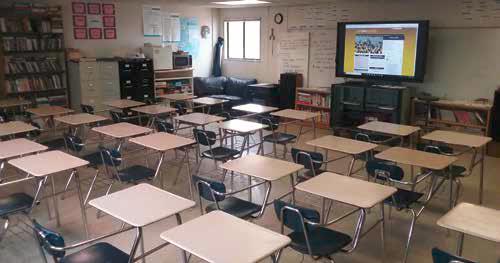
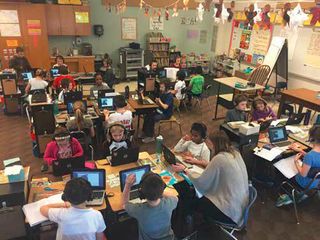
Edtech tools are helping educators everywhere discover new possibilities for writing instruction. Teachers are happier. They’re reading student work that’s more thoughtful, properly revised, and well researched, and they’re able to give efficient, effective feedback to each student. The teetering stacks of papers waiting to be graded are gone. Trees are happier. And writing students at every level who are inspired by engaging prompts and able to share, collaborate, and access support and informative texts are happier too.
OVER TWO MILLION WORDS IN FOUR WEEKS
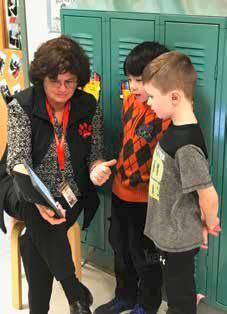
At Milton (MA) Public Schools last February, 758 fourth- and fifth-grade students engaged in a four-week collaborative story writing experience. They wrote for a total of 78,873 minutes and produced 2,245,621 words. The first annual BoomWriter Writing Bee, in collaboration with Jeff Cohen (aka “Chunk” from the Goonies), coincided with standardized testing season. “We saw a huge improvement in our students’ ability to write effectively and to type efficiently,” says curriculum coordinator Amy Gale. “It was an authentic and fun way for students to prepare for the state tests without even realizing that they were!” Teachers reported that 100 percent of participating students were “engaged” or “extremely engaged.” As a sequel to last year’s success, students are busy completing a four-chapter book with Diary of a Wimpy Kid author Jeff Kinney.
INVESTMENTS IN TEACHER TRAINING AND TECH
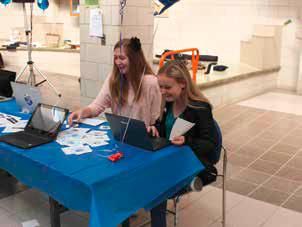
The key backstory here is Milton Public Schools’ larger commitment to writing instruction across grade levels and subject areas. “All of our teachers have had ample professional development in writing process and pedagogy, which helps to provide a strong knowledge base around the most effective practices,” says Gale. The district is seeing great results from its investment in technology-based tools and in training teachers to use them. Students are using Google Classroom, BoomWriter, Reach for Reading, and other tools across the curriculum. “Our goal is to provide ample opportunities for students to develop strong writing skills across genres, in response to reading and in on-demand tasks,” Gale says. Gale calls the online program BoomWriter “perhaps the most impactful technologybased tool that we’ve used to support writing instruction.” Teachers in grades three through five utilize BoomWriter in math, science, ELA, and social studies, as it reinforces grade-level content, builds typing skills and stamina in revising and editing, and engages students. BoomWriter’s rubrics and gradebook feature simplify the process of grading and tracking student growth, and its peer review component helps students to reflect on their work and to continually strive for quality.
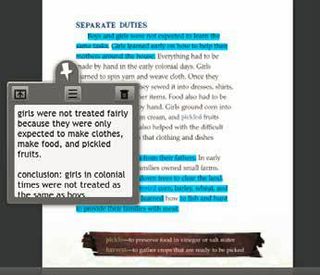
TOOLS THEY USE
MILTON PUBLIC SCHOOLS
Tech & Learning Newsletter
Tools and ideas to transform education. Sign up below.
BoomWriter
Chromebooks
FlipGrid
Google Classroom
iPads
Reach for Reading
SeeSaw
Study Island
IMMERSION IN THE GENRE
Stephen Samuels’ fifth-grade ELA students at Mosaic Preparatory Academy in Manhattan (NY) benefit from a total-immersion experience in each genre—whether they’re studying, reading, or writing narrative fiction or informative writing. “This provides a structural understanding of the genre and provides mentor texts that students can use as models for their own writing,” Samuels says. With online reading resources (from myON, for example), he adds, teachers can devise complete research and writing assignments and students can access text and write on one device.
TOOLS THEY USE
MOSAIC PREPARATORY ACADEMY
First in Math
Fluency Tutor for Google
Google Drive
iPads
Laptops
myON
Promethean boards
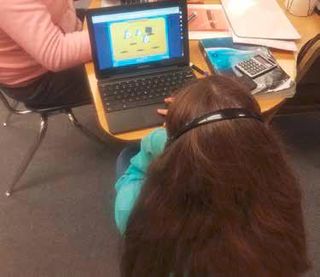
Samuels also teaches students how to dictate on Google Drive, which integrates with Lucy Calkins’ Teachers College Reading and Writing Project “Writing in the Air” (rehearsing what you want to write by saying it out loud). “This process enables students to dictate their flash drafts, which are the most difficult part of writing,” Samuels says. Once they have a draft, Samuels finds his emerging writers are more motivated and willing to make major revisions because online tools make revising so easy. Google Drive also enables Samuels to have more frequent and effective virtual conferences with every student.
MAKING WRITING GREAT
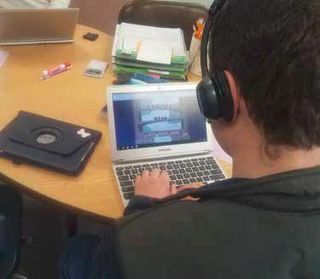
In conjunction with Black History Month, Samuels’ students read a diary of a free African- American woman who lived during post-Civil War Reconstruction, then they rewrote portions of it from the point of view of a Caucasian person during that same time period. His special ed class researched how people, mostly women and African-Americans, helped make America great. All of these tools and resources, including grade-level texts on myON, enable “savvy teachers to curate interdisciplinary projects that are accessible to all students within a classroom,” says Samuels.
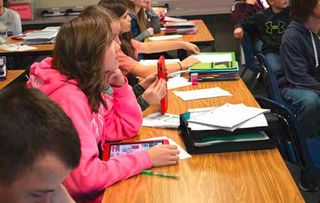
TEACHING WRITING IS MORE IMPORTANT THAN EVER
“Writing is a natural response to processing information that students are learning in all classes,” says Kate Hertz, English teacher at Geneva (IL) High School. With their in-progress rollout of 1:1 laptops and teachers using a vast array of applications, Hertz says, “Technology has helped to increase students’ level of writing organically—across the curriculum.”
But because everyone with a device can write and publish their ideas so easily, Hertz says, “Students often come to school with a false sense of expertise in written expression—or they’re intimidated because they ‘can’t write like the experts.’” Teaching the various modes in which students can express themselves in written form, and how and why they choose each one, is more important than ever. “As a result, we’ve sought out new ways to engage students in authentic and seamless writing processes using tools like OneNote and StudySync,” Hertz says.
TOOLS THEY USE
GENEVA HIGH SCHOOL
Laptops
Microsoft Office 365
OneNote
StudySync
MAKING WRITING A PRIORITY
How can eighth-grade students at Oriole Park School (IL) deconstruct a complex text about Shakespeare? Thanks to a cross-curricular writing plan and a focus on writing instruction at this
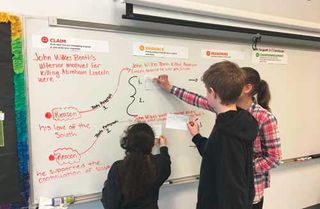
pre-K through 8 school in Chicago, all students are learning to think, and write, critically. In the primary and intermediate grades, says principal Tim Riff, teachers employ the Writer’s Workshop model. Students write in different genres, in each discipline except for math, and enjoy dedicated writing time, instruction, and conferences with teachers. With tools like Google Docs, students can work on their writing “at school, at home, and in between,” Riff says, and “while the use of fonts and pictures can seem ancillary, these aspects of writing increase engagement through individual creativity and allow students to feel ownership.” Making writing a priority is difficult work, Riff says. Teams of teachers meet monthly to examine student writing samples. “This analysis informs our progress towards our year-end goals and helps us to identify skills for remediation and enrichment,” he says.
FOR THE SAKE OF ARGUMENT
Because of departmentalization at the middle-school level, writing has to be intentionally taught and practiced in each classroom. “Think CERCA has been an invaluable tool for us to align writing instruction and bring consistency to expectations and language
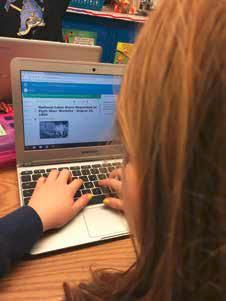
when teaching and talking about writing,” Riff says. “The CERCA framework (claim, evidence, reasoning, counterargument, audience) supports students to organize their thoughts and include of all the necessary elements of an argumentative piece.” One measure of success is seeing students utilizing this framework, and being mindful about including evidence, when they’re writing independently of the online platform. When they can use the elements of a claim to clearly communicate ideas, they have “real-world, practical strategies for communication.”
TOOLS THEY USE
ORIOLE ELEMENTARY
Khan Academy
Reading A–Z
Study Island
ThinkCERCA
Xtra Math
STARTING AT THE VERY BEGINNING
Once her students learned to read, says JaLynn Tuckett, special education teacher at Raft River Schools in Cassia (ID) School District 151, “I knew everything else would open up to them.” But her students, in this small rural community with many English language learners, migrant students, and lower income families, were so far behind that they hated reading. The district has a limited budget for technology, so Tuckett found Reading Horizons and began with direct instruction only. She soon discovered, however, that students weren’t even able to verbalize sentences that made sense. “So,” she says, “we started there.” Students’ reading levels began to improve as they engaged in decoding activities and memory and matching games. When Tuckett purchased high-interest/low-reading-level books, she says, “they actually started reading!” Using Epic! for Educators, students began listening to stories they couldn’t master yet and fell in love with books. Tuckett was then able to purchase the online Reading Horizons program, which boosted students’ reading levels still further, in addition to helping them with vocabulary, spelling, and grammar.
TOOLS THEY USE
RAFT RIVER SCHOOLS
Epic! for Educators
Laptops
Reading Horizons
Discovery and Elevate
READERS BECOME WRITERS
As the students read more and more and were exposed to different types of writing, Tuckett says, they were able to see and hear how good sentences and paragraphs look and sound. She’s thrilled to see the progress when her students’ general education teachers show her copies of their writing. In fact, one general education teacher has noted that a special education student is one of the better writers in the class. An amazing 80 percent of Tuckett’s students have gone from scoring a 0 or 1 on their district writing benchmark to scoring 2s. “We are not quite to 3s (proficient), but we are moving closer,” she says. “Because of Reading Horizons Discovery and Elevate,” Tuckett says, “my kids are better readers, lovers of literature, and so much more confident and competent in their writing!”
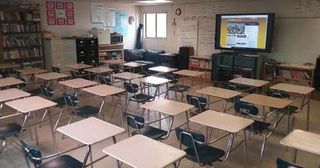
ESSAYS WAITING TO BE MARKED
At Albuquerque (NM) Public Schools’ Cibola High School, ELA teacher Marc Raugust’s students write nearly every day. “My students need to see that writing is a thinking tool and not just something they do for essays or final projects,” he says. All of that writing, however, requires lots of teacher time and feedback. Raugust has used Google Docs for years and recently discovered how “truly awesome” Google Classroom is for creating and sharing assignments and self-graded quizzes. But, he says, “the essays still just sit there, waiting to be marked.” He didn’t find Google Docs’ built-in commenting features faster or better. “Why not just stay with what I know—print out the paper and mark it by hand,” he concluded.
TOOLS THEY USE
CIBOLA HIGH SCHOOL
EdPuzzle
Google Classroom
iPads
Laptops
PCs
Promethean boards
THE KILLER EXTENSION FOR GRADING
But then Raugust found the Google Chrome extension Annotate PRO. “It’s awesome, customizable, and quick,” he says. He created a personal library of customized comments addressing the issues his students frequently have, along with links to Web pages and YouTube videos to provide solutions. “My comments sound like me—because I wrote them. It’s the killer extension for grading in Google Docs,” Raugust says. When a group of students redrafted introductions recently, Raugust watched over their shoulders as the videos he’d embedded in his comments popped up. “Those kids improved right away, and their rewritten introductions were objectively better. It was pretty cool. I didn’t have to say the same thing to five kids, five different times. One comment, one good link, and off they went.” In addition, students “get to hear from another expert, a different perspective,” and students say they prefer these types of comments and find them helpful. Raugust also wants to explore sharing his comment library with colleagues to see if it’s worthwhile using with common assessments and shared rubrics. While it’s still early days, he says, “I think that’s a positive start.”
BEYOND PRACTICE TO PROCESS
At Coeur d’Alene (ID) School District, educators are adopting new curricula and edtech tools to encourage every one of their 11,000 students to connect their learning across content areas. And writing, says director of curricula and assessments Michael Nelson, is the core process through which students funnel concepts and ideas to synthesize and articulate what they’re thinking. To help students move beyond practice to develop this higher-level process, the district recently implemented Turnitin’s Revision Assistant and Feedback Studio to complement the use of Google Docs for writing instruction in their middle and high schools. With Feedback Studio, Nelson says, the days of teachers having to comb through papers to check for plagiarism are over. He estimates that the percentage of plagiarized senior research papers fell from about 20 percent to just 8 percent last year.
TOOLS THEY USE
COEUR D’ALENE
Chromebooks
Google Classroom
iPads
Keyboarding Without Tears
Turnitin
LIVE, REAL-TIME FEEDBACK
With Revision Assistant, students receive live, real-time feedback as they write—on everything from grammar and syntax to their analysis and arguments, which encourages them to think more deeply and critically. Teachers receive reports in real time, and they can also drop in feedback and see how much effort students have put into improving their drafts. Nelson notes that their students now go through an average of 7.9 revisions before turning in their work. Revision Assistant dovetails nicely with Google tools, says director of technology Seth Deniston. Teachers have found it “revolutionary,” and the tool is intuitive and seamless for both teachers and students to use. Nelson ran some of his PhD thesis through Revision Assistant and was impressed with the feedback he received. “This tool could have saved me a lot,” he jokes. Regular PD sessions have been key for the rollout of both tools, and the district will introduce Revision Assistant at their magnet elementary school focused on writing next year. Keyboarding Without Tears, which integrates tightly into holistic writing instruction and includes strong literacy components, is preparing K–5 students throughout the district, Deniston says, for all the writing they’ll do on devices—all the way to their culminating senior projects and beyond.











